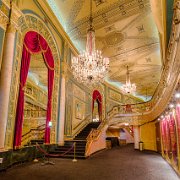
1 The Capitol Theatre was considered Detroit’s first official movie palace, and when it opened January 12, 1922, it sat about 3,500, the fifth largest ever built in the US at the time.
Its architect, C. Howard Crane, designed the Capitol Theatre in the style of the Italian Renaissance, and its facade, with its soaring Corinthian columns, loomed over Broadway like a royal palace. Its interior was even more ornate, with several kinds of marble, Tiffany mosaics, sculpture and gilt decorating its lobby and other areas. The Capitol Theatre is said to have cost over $2 million to build.
The 35-piece ‘Great Capitol Wonder Orchestra’, led by Eduard Werner, was on hand opening day, and remained a popular feature of the theatre until he left the Capitol Theatre for the Michigan Theater in 1926. On screen, “The Lotus Eater” was shown, as well as footage of guests entering the theatre two hours earlier, much to the audience’s amazement and delight.
The theatre’s name was changed to the Paramount Theatre on August 30, 1929, when it was taken over by the Paramount-Publix chain, and featured live stage shows and vaudeville acts. Stars who appeared on the Paramount Theatre’s stage in those days included W.C. Fields, Fatty Arbuckle, and Guy Lombardo and his Orchestra.
As a result of the Depression, the theatre closed in 1932, but only until August31, 1934, when it reopened under United Detroit Theaters with another new name, this time the Broadway-Capitol Theatre.
In the 1940’s and 1950’s, management of the theatre passed back and forth between various parties, but it was managed by United Detroit Theaters once again beginning in 1960.
For most of the 1950’s, the Broadway-Capitol Theatre featured second-run films and double-features, and unlike many other area theatres, did not convert to the widescreen format to attract audiences.
It was in 1960 that United Detroit Theaters poured over $100,000 into remodeling the theatre, completely changing its facade and slightly reducing its seating capacity.
It was also given yet another new name during this time, the Grand Circus Theatre, continuing to screen second-run films. The theatre often struggled during the 1960’s and 1970’s, but remained open until 1978, with the last film on its screen being “Jailbait Babysitter”.
During the early-to-mid-1980’s, the Grand Circus Theatre was used for concerts, but was forced to close in 1985 after a fire broke out.
In 1989, the Michigan Opera Theatre purchased the Grand Circus Theatre and nearby Madison Theatre for $3.5 million and began a $20 million campaign to restore the interior of the old Capitol Theatre to its 1920’s appearance, enlarge its stage, improve the sound and lighting systems, and reduce seating to a more comfortable 2,700.
It now serves as the Detroit Opera House.
Its architect, C. Howard Crane, designed the Capitol Theatre in the style of the Italian Renaissance, and its facade, with its soaring Corinthian columns, loomed over Broadway like a royal palace. Its interior was even more ornate, with several kinds of marble, Tiffany mosaics, sculpture and gilt decorating its lobby and other areas. The Capitol Theatre is said to have cost over $2 million to build.
The 35-piece ‘Great Capitol Wonder Orchestra’, led by Eduard Werner, was on hand opening day, and remained a popular feature of the theatre until he left the Capitol Theatre for the Michigan Theater in 1926. On screen, “The Lotus Eater” was shown, as well as footage of guests entering the theatre two hours earlier, much to the audience’s amazement and delight.
The theatre’s name was changed to the Paramount Theatre on August 30, 1929, when it was taken over by the Paramount-Publix chain, and featured live stage shows and vaudeville acts. Stars who appeared on the Paramount Theatre’s stage in those days included W.C. Fields, Fatty Arbuckle, and Guy Lombardo and his Orchestra.
As a result of the Depression, the theatre closed in 1932, but only until August31, 1934, when it reopened under United Detroit Theaters with another new name, this time the Broadway-Capitol Theatre.
In the 1940’s and 1950’s, management of the theatre passed back and forth between various parties, but it was managed by United Detroit Theaters once again beginning in 1960.
For most of the 1950’s, the Broadway-Capitol Theatre featured second-run films and double-features, and unlike many other area theatres, did not convert to the widescreen format to attract audiences.
It was in 1960 that United Detroit Theaters poured over $100,000 into remodeling the theatre, completely changing its facade and slightly reducing its seating capacity.
It was also given yet another new name during this time, the Grand Circus Theatre, continuing to screen second-run films. The theatre often struggled during the 1960’s and 1970’s, but remained open until 1978, with the last film on its screen being “Jailbait Babysitter”.
During the early-to-mid-1980’s, the Grand Circus Theatre was used for concerts, but was forced to close in 1985 after a fire broke out.
In 1989, the Michigan Opera Theatre purchased the Grand Circus Theatre and nearby Madison Theatre for $3.5 million and began a $20 million campaign to restore the interior of the old Capitol Theatre to its 1920’s appearance, enlarge its stage, improve the sound and lighting systems, and reduce seating to a more comfortable 2,700.
It now serves as the Detroit Opera House.
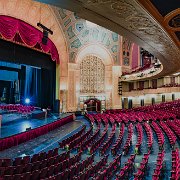
2 The Capitol Theatre was considered Detroit’s first official movie palace, and when it opened January 12, 1922, it sat about 3,500, the fifth largest ever built in the US at the time.
Its architect, C. Howard Crane, designed the Capitol Theatre in the style of the Italian Renaissance, and its facade, with its soaring Corinthian columns, loomed over Broadway like a royal palace. Its interior was even more ornate, with several kinds of marble, Tiffany mosaics, sculpture and gilt decorating its lobby and other areas. The Capitol Theatre is said to have cost over $2 million to build.
The 35-piece ‘Great Capitol Wonder Orchestra’, led by Eduard Werner, was on hand opening day, and remained a popular feature of the theatre until he left the Capitol Theatre for the Michigan Theater in 1926. On screen, “The Lotus Eater” was shown, as well as footage of guests entering the theatre two hours earlier, much to the audience’s amazement and delight.
The theatre’s name was changed to the Paramount Theatre on August 30, 1929, when it was taken over by the Paramount-Publix chain, and featured live stage shows and vaudeville acts. Stars who appeared on the Paramount Theatre’s stage in those days included W.C. Fields, Fatty Arbuckle, and Guy Lombardo and his Orchestra.
As a result of the Depression, the theatre closed in 1932, but only until August31, 1934, when it reopened under United Detroit Theaters with another new name, this time the Broadway-Capitol Theatre.
In the 1940’s and 1950’s, management of the theatre passed back and forth between various parties, but it was managed by United Detroit Theaters once again beginning in 1960.
For most of the 1950’s, the Broadway-Capitol Theatre featured second-run films and double-features, and unlike many other area theatres, did not convert to the widescreen format to attract audiences.
It was in 1960 that United Detroit Theaters poured over $100,000 into remodeling the theatre, completely changing its facade and slightly reducing its seating capacity.
It was also given yet another new name during this time, the Grand Circus Theatre, continuing to screen second-run films. The theatre often struggled during the 1960’s and 1970’s, but remained open until 1978, with the last film on its screen being “Jailbait Babysitter”.
During the early-to-mid-1980’s, the Grand Circus Theatre was used for concerts, but was forced to close in 1985 after a fire broke out.
In 1989, the Michigan Opera Theatre purchased the Grand Circus Theatre and nearby Madison Theatre for $3.5 million and began a $20 million campaign to restore the interior of the old Capitol Theatre to its 1920’s appearance, enlarge its stage, improve the sound and lighting systems, and reduce seating to a more comfortable 2,700.
It now serves as the Detroit Opera House.
Its architect, C. Howard Crane, designed the Capitol Theatre in the style of the Italian Renaissance, and its facade, with its soaring Corinthian columns, loomed over Broadway like a royal palace. Its interior was even more ornate, with several kinds of marble, Tiffany mosaics, sculpture and gilt decorating its lobby and other areas. The Capitol Theatre is said to have cost over $2 million to build.
The 35-piece ‘Great Capitol Wonder Orchestra’, led by Eduard Werner, was on hand opening day, and remained a popular feature of the theatre until he left the Capitol Theatre for the Michigan Theater in 1926. On screen, “The Lotus Eater” was shown, as well as footage of guests entering the theatre two hours earlier, much to the audience’s amazement and delight.
The theatre’s name was changed to the Paramount Theatre on August 30, 1929, when it was taken over by the Paramount-Publix chain, and featured live stage shows and vaudeville acts. Stars who appeared on the Paramount Theatre’s stage in those days included W.C. Fields, Fatty Arbuckle, and Guy Lombardo and his Orchestra.
As a result of the Depression, the theatre closed in 1932, but only until August31, 1934, when it reopened under United Detroit Theaters with another new name, this time the Broadway-Capitol Theatre.
In the 1940’s and 1950’s, management of the theatre passed back and forth between various parties, but it was managed by United Detroit Theaters once again beginning in 1960.
For most of the 1950’s, the Broadway-Capitol Theatre featured second-run films and double-features, and unlike many other area theatres, did not convert to the widescreen format to attract audiences.
It was in 1960 that United Detroit Theaters poured over $100,000 into remodeling the theatre, completely changing its facade and slightly reducing its seating capacity.
It was also given yet another new name during this time, the Grand Circus Theatre, continuing to screen second-run films. The theatre often struggled during the 1960’s and 1970’s, but remained open until 1978, with the last film on its screen being “Jailbait Babysitter”.
During the early-to-mid-1980’s, the Grand Circus Theatre was used for concerts, but was forced to close in 1985 after a fire broke out.
In 1989, the Michigan Opera Theatre purchased the Grand Circus Theatre and nearby Madison Theatre for $3.5 million and began a $20 million campaign to restore the interior of the old Capitol Theatre to its 1920’s appearance, enlarge its stage, improve the sound and lighting systems, and reduce seating to a more comfortable 2,700.
It now serves as the Detroit Opera House.
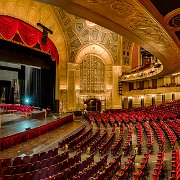
3 The Capitol Theatre was considered Detroit’s first official movie palace, and when it opened January 12, 1922, it sat about 3,500, the fifth largest ever built in the US at the time.
Its architect, C. Howard Crane, designed the Capitol Theatre in the style of the Italian Renaissance, and its facade, with its soaring Corinthian columns, loomed over Broadway like a royal palace. Its interior was even more ornate, with several kinds of marble, Tiffany mosaics, sculpture and gilt decorating its lobby and other areas. The Capitol Theatre is said to have cost over $2 million to build.
The 35-piece ‘Great Capitol Wonder Orchestra’, led by Eduard Werner, was on hand opening day, and remained a popular feature of the theatre until he left the Capitol Theatre for the Michigan Theater in 1926. On screen, “The Lotus Eater” was shown, as well as footage of guests entering the theatre two hours earlier, much to the audience’s amazement and delight.
The theatre’s name was changed to the Paramount Theatre on August 30, 1929, when it was taken over by the Paramount-Publix chain, and featured live stage shows and vaudeville acts. Stars who appeared on the Paramount Theatre’s stage in those days included W.C. Fields, Fatty Arbuckle, and Guy Lombardo and his Orchestra.
As a result of the Depression, the theatre closed in 1932, but only until August31, 1934, when it reopened under United Detroit Theaters with another new name, this time the Broadway-Capitol Theatre.
In the 1940’s and 1950’s, management of the theatre passed back and forth between various parties, but it was managed by United Detroit Theaters once again beginning in 1960.
For most of the 1950’s, the Broadway-Capitol Theatre featured second-run films and double-features, and unlike many other area theatres, did not convert to the widescreen format to attract audiences.
It was in 1960 that United Detroit Theaters poured over $100,000 into remodeling the theatre, completely changing its facade and slightly reducing its seating capacity.
It was also given yet another new name during this time, the Grand Circus Theatre, continuing to screen second-run films. The theatre often struggled during the 1960’s and 1970’s, but remained open until 1978, with the last film on its screen being “Jailbait Babysitter”.
During the early-to-mid-1980’s, the Grand Circus Theatre was used for concerts, but was forced to close in 1985 after a fire broke out.
In 1989, the Michigan Opera Theatre purchased the Grand Circus Theatre and nearby Madison Theatre for $3.5 million and began a $20 million campaign to restore the interior of the old Capitol Theatre to its 1920’s appearance, enlarge its stage, improve the sound and lighting systems, and reduce seating to a more comfortable 2,700.
It now serves as the Detroit Opera House.
Its architect, C. Howard Crane, designed the Capitol Theatre in the style of the Italian Renaissance, and its facade, with its soaring Corinthian columns, loomed over Broadway like a royal palace. Its interior was even more ornate, with several kinds of marble, Tiffany mosaics, sculpture and gilt decorating its lobby and other areas. The Capitol Theatre is said to have cost over $2 million to build.
The 35-piece ‘Great Capitol Wonder Orchestra’, led by Eduard Werner, was on hand opening day, and remained a popular feature of the theatre until he left the Capitol Theatre for the Michigan Theater in 1926. On screen, “The Lotus Eater” was shown, as well as footage of guests entering the theatre two hours earlier, much to the audience’s amazement and delight.
The theatre’s name was changed to the Paramount Theatre on August 30, 1929, when it was taken over by the Paramount-Publix chain, and featured live stage shows and vaudeville acts. Stars who appeared on the Paramount Theatre’s stage in those days included W.C. Fields, Fatty Arbuckle, and Guy Lombardo and his Orchestra.
As a result of the Depression, the theatre closed in 1932, but only until August31, 1934, when it reopened under United Detroit Theaters with another new name, this time the Broadway-Capitol Theatre.
In the 1940’s and 1950’s, management of the theatre passed back and forth between various parties, but it was managed by United Detroit Theaters once again beginning in 1960.
For most of the 1950’s, the Broadway-Capitol Theatre featured second-run films and double-features, and unlike many other area theatres, did not convert to the widescreen format to attract audiences.
It was in 1960 that United Detroit Theaters poured over $100,000 into remodeling the theatre, completely changing its facade and slightly reducing its seating capacity.
It was also given yet another new name during this time, the Grand Circus Theatre, continuing to screen second-run films. The theatre often struggled during the 1960’s and 1970’s, but remained open until 1978, with the last film on its screen being “Jailbait Babysitter”.
During the early-to-mid-1980’s, the Grand Circus Theatre was used for concerts, but was forced to close in 1985 after a fire broke out.
In 1989, the Michigan Opera Theatre purchased the Grand Circus Theatre and nearby Madison Theatre for $3.5 million and began a $20 million campaign to restore the interior of the old Capitol Theatre to its 1920’s appearance, enlarge its stage, improve the sound and lighting systems, and reduce seating to a more comfortable 2,700.
It now serves as the Detroit Opera House.
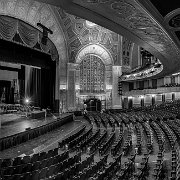
4 The Capitol Theatre was considered Detroit’s first official movie palace, and when it opened January 12, 1922, it sat about 3,500, the fifth largest ever built in the US at the time.
Its architect, C. Howard Crane, designed the Capitol Theatre in the style of the Italian Renaissance, and its facade, with its soaring Corinthian columns, loomed over Broadway like a royal palace. Its interior was even more ornate, with several kinds of marble, Tiffany mosaics, sculpture and gilt decorating its lobby and other areas. The Capitol Theatre is said to have cost over $2 million to build.
The 35-piece ‘Great Capitol Wonder Orchestra’, led by Eduard Werner, was on hand opening day, and remained a popular feature of the theatre until he left the Capitol Theatre for the Michigan Theater in 1926. On screen, “The Lotus Eater” was shown, as well as footage of guests entering the theatre two hours earlier, much to the audience’s amazement and delight.
The theatre’s name was changed to the Paramount Theatre on August 30, 1929, when it was taken over by the Paramount-Publix chain, and featured live stage shows and vaudeville acts. Stars who appeared on the Paramount Theatre’s stage in those days included W.C. Fields, Fatty Arbuckle, and Guy Lombardo and his Orchestra.
As a result of the Depression, the theatre closed in 1932, but only until August31, 1934, when it reopened under United Detroit Theaters with another new name, this time the Broadway-Capitol Theatre.
In the 1940’s and 1950’s, management of the theatre passed back and forth between various parties, but it was managed by United Detroit Theaters once again beginning in 1960.
For most of the 1950’s, the Broadway-Capitol Theatre featured second-run films and double-features, and unlike many other area theatres, did not convert to the widescreen format to attract audiences.
It was in 1960 that United Detroit Theaters poured over $100,000 into remodeling the theatre, completely changing its facade and slightly reducing its seating capacity.
It was also given yet another new name during this time, the Grand Circus Theatre, continuing to screen second-run films. The theatre often struggled during the 1960’s and 1970’s, but remained open until 1978, with the last film on its screen being “Jailbait Babysitter”.
During the early-to-mid-1980’s, the Grand Circus Theatre was used for concerts, but was forced to close in 1985 after a fire broke out.
In 1989, the Michigan Opera Theatre purchased the Grand Circus Theatre and nearby Madison Theatre for $3.5 million and began a $20 million campaign to restore the interior of the old Capitol Theatre to its 1920’s appearance, enlarge its stage, improve the sound and lighting systems, and reduce seating to a more comfortable 2,700.
It now serves as the Detroit Opera House.
Its architect, C. Howard Crane, designed the Capitol Theatre in the style of the Italian Renaissance, and its facade, with its soaring Corinthian columns, loomed over Broadway like a royal palace. Its interior was even more ornate, with several kinds of marble, Tiffany mosaics, sculpture and gilt decorating its lobby and other areas. The Capitol Theatre is said to have cost over $2 million to build.
The 35-piece ‘Great Capitol Wonder Orchestra’, led by Eduard Werner, was on hand opening day, and remained a popular feature of the theatre until he left the Capitol Theatre for the Michigan Theater in 1926. On screen, “The Lotus Eater” was shown, as well as footage of guests entering the theatre two hours earlier, much to the audience’s amazement and delight.
The theatre’s name was changed to the Paramount Theatre on August 30, 1929, when it was taken over by the Paramount-Publix chain, and featured live stage shows and vaudeville acts. Stars who appeared on the Paramount Theatre’s stage in those days included W.C. Fields, Fatty Arbuckle, and Guy Lombardo and his Orchestra.
As a result of the Depression, the theatre closed in 1932, but only until August31, 1934, when it reopened under United Detroit Theaters with another new name, this time the Broadway-Capitol Theatre.
In the 1940’s and 1950’s, management of the theatre passed back and forth between various parties, but it was managed by United Detroit Theaters once again beginning in 1960.
For most of the 1950’s, the Broadway-Capitol Theatre featured second-run films and double-features, and unlike many other area theatres, did not convert to the widescreen format to attract audiences.
It was in 1960 that United Detroit Theaters poured over $100,000 into remodeling the theatre, completely changing its facade and slightly reducing its seating capacity.
It was also given yet another new name during this time, the Grand Circus Theatre, continuing to screen second-run films. The theatre often struggled during the 1960’s and 1970’s, but remained open until 1978, with the last film on its screen being “Jailbait Babysitter”.
During the early-to-mid-1980’s, the Grand Circus Theatre was used for concerts, but was forced to close in 1985 after a fire broke out.
In 1989, the Michigan Opera Theatre purchased the Grand Circus Theatre and nearby Madison Theatre for $3.5 million and began a $20 million campaign to restore the interior of the old Capitol Theatre to its 1920’s appearance, enlarge its stage, improve the sound and lighting systems, and reduce seating to a more comfortable 2,700.
It now serves as the Detroit Opera House.
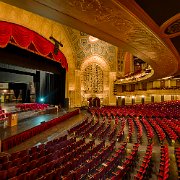
5 The Capitol Theatre was considered Detroit’s first official movie palace, and when it opened January 12, 1922, it sat about 3,500, the fifth largest ever built in the US at the time.
Its architect, C. Howard Crane, designed the Capitol Theatre in the style of the Italian Renaissance, and its facade, with its soaring Corinthian columns, loomed over Broadway like a royal palace. Its interior was even more ornate, with several kinds of marble, Tiffany mosaics, sculpture and gilt decorating its lobby and other areas. The Capitol Theatre is said to have cost over $2 million to build.
The 35-piece ‘Great Capitol Wonder Orchestra’, led by Eduard Werner, was on hand opening day, and remained a popular feature of the theatre until he left the Capitol Theatre for the Michigan Theater in 1926. On screen, “The Lotus Eater” was shown, as well as footage of guests entering the theatre two hours earlier, much to the audience’s amazement and delight.
The theatre’s name was changed to the Paramount Theatre on August 30, 1929, when it was taken over by the Paramount-Publix chain, and featured live stage shows and vaudeville acts. Stars who appeared on the Paramount Theatre’s stage in those days included W.C. Fields, Fatty Arbuckle, and Guy Lombardo and his Orchestra.
As a result of the Depression, the theatre closed in 1932, but only until August31, 1934, when it reopened under United Detroit Theaters with another new name, this time the Broadway-Capitol Theatre.
In the 1940’s and 1950’s, management of the theatre passed back and forth between various parties, but it was managed by United Detroit Theaters once again beginning in 1960.
For most of the 1950’s, the Broadway-Capitol Theatre featured second-run films and double-features, and unlike many other area theatres, did not convert to the widescreen format to attract audiences.
It was in 1960 that United Detroit Theaters poured over $100,000 into remodeling the theatre, completely changing its facade and slightly reducing its seating capacity.
It was also given yet another new name during this time, the Grand Circus Theatre, continuing to screen second-run films. The theatre often struggled during the 1960’s and 1970’s, but remained open until 1978, with the last film on its screen being “Jailbait Babysitter”.
During the early-to-mid-1980’s, the Grand Circus Theatre was used for concerts, but was forced to close in 1985 after a fire broke out.
In 1989, the Michigan Opera Theatre purchased the Grand Circus Theatre and nearby Madison Theatre for $3.5 million and began a $20 million campaign to restore the interior of the old Capitol Theatre to its 1920’s appearance, enlarge its stage, improve the sound and lighting systems, and reduce seating to a more comfortable 2,700.
It now serves as the Detroit Opera House.
Its architect, C. Howard Crane, designed the Capitol Theatre in the style of the Italian Renaissance, and its facade, with its soaring Corinthian columns, loomed over Broadway like a royal palace. Its interior was even more ornate, with several kinds of marble, Tiffany mosaics, sculpture and gilt decorating its lobby and other areas. The Capitol Theatre is said to have cost over $2 million to build.
The 35-piece ‘Great Capitol Wonder Orchestra’, led by Eduard Werner, was on hand opening day, and remained a popular feature of the theatre until he left the Capitol Theatre for the Michigan Theater in 1926. On screen, “The Lotus Eater” was shown, as well as footage of guests entering the theatre two hours earlier, much to the audience’s amazement and delight.
The theatre’s name was changed to the Paramount Theatre on August 30, 1929, when it was taken over by the Paramount-Publix chain, and featured live stage shows and vaudeville acts. Stars who appeared on the Paramount Theatre’s stage in those days included W.C. Fields, Fatty Arbuckle, and Guy Lombardo and his Orchestra.
As a result of the Depression, the theatre closed in 1932, but only until August31, 1934, when it reopened under United Detroit Theaters with another new name, this time the Broadway-Capitol Theatre.
In the 1940’s and 1950’s, management of the theatre passed back and forth between various parties, but it was managed by United Detroit Theaters once again beginning in 1960.
For most of the 1950’s, the Broadway-Capitol Theatre featured second-run films and double-features, and unlike many other area theatres, did not convert to the widescreen format to attract audiences.
It was in 1960 that United Detroit Theaters poured over $100,000 into remodeling the theatre, completely changing its facade and slightly reducing its seating capacity.
It was also given yet another new name during this time, the Grand Circus Theatre, continuing to screen second-run films. The theatre often struggled during the 1960’s and 1970’s, but remained open until 1978, with the last film on its screen being “Jailbait Babysitter”.
During the early-to-mid-1980’s, the Grand Circus Theatre was used for concerts, but was forced to close in 1985 after a fire broke out.
In 1989, the Michigan Opera Theatre purchased the Grand Circus Theatre and nearby Madison Theatre for $3.5 million and began a $20 million campaign to restore the interior of the old Capitol Theatre to its 1920’s appearance, enlarge its stage, improve the sound and lighting systems, and reduce seating to a more comfortable 2,700.
It now serves as the Detroit Opera House.
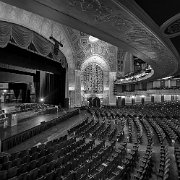
6 The Capitol Theatre was considered Detroit’s first official movie palace, and when it opened January 12, 1922, it sat about 3,500, the fifth largest ever built in the US at the time.
Its architect, C. Howard Crane, designed the Capitol Theatre in the style of the Italian Renaissance, and its facade, with its soaring Corinthian columns, loomed over Broadway like a royal palace. Its interior was even more ornate, with several kinds of marble, Tiffany mosaics, sculpture and gilt decorating its lobby and other areas. The Capitol Theatre is said to have cost over $2 million to build.
The 35-piece ‘Great Capitol Wonder Orchestra’, led by Eduard Werner, was on hand opening day, and remained a popular feature of the theatre until he left the Capitol Theatre for the Michigan Theater in 1926. On screen, “The Lotus Eater” was shown, as well as footage of guests entering the theatre two hours earlier, much to the audience’s amazement and delight.
The theatre’s name was changed to the Paramount Theatre on August 30, 1929, when it was taken over by the Paramount-Publix chain, and featured live stage shows and vaudeville acts. Stars who appeared on the Paramount Theatre’s stage in those days included W.C. Fields, Fatty Arbuckle, and Guy Lombardo and his Orchestra.
As a result of the Depression, the theatre closed in 1932, but only until August31, 1934, when it reopened under United Detroit Theaters with another new name, this time the Broadway-Capitol Theatre.
In the 1940’s and 1950’s, management of the theatre passed back and forth between various parties, but it was managed by United Detroit Theaters once again beginning in 1960.
For most of the 1950’s, the Broadway-Capitol Theatre featured second-run films and double-features, and unlike many other area theatres, did not convert to the widescreen format to attract audiences.
It was in 1960 that United Detroit Theaters poured over $100,000 into remodeling the theatre, completely changing its facade and slightly reducing its seating capacity.
It was also given yet another new name during this time, the Grand Circus Theatre, continuing to screen second-run films. The theatre often struggled during the 1960’s and 1970’s, but remained open until 1978, with the last film on its screen being “Jailbait Babysitter”.
During the early-to-mid-1980’s, the Grand Circus Theatre was used for concerts, but was forced to close in 1985 after a fire broke out.
In 1989, the Michigan Opera Theatre purchased the Grand Circus Theatre and nearby Madison Theatre for $3.5 million and began a $20 million campaign to restore the interior of the old Capitol Theatre to its 1920’s appearance, enlarge its stage, improve the sound and lighting systems, and reduce seating to a more comfortable 2,700.
It now serves as the Detroit Opera House.
Its architect, C. Howard Crane, designed the Capitol Theatre in the style of the Italian Renaissance, and its facade, with its soaring Corinthian columns, loomed over Broadway like a royal palace. Its interior was even more ornate, with several kinds of marble, Tiffany mosaics, sculpture and gilt decorating its lobby and other areas. The Capitol Theatre is said to have cost over $2 million to build.
The 35-piece ‘Great Capitol Wonder Orchestra’, led by Eduard Werner, was on hand opening day, and remained a popular feature of the theatre until he left the Capitol Theatre for the Michigan Theater in 1926. On screen, “The Lotus Eater” was shown, as well as footage of guests entering the theatre two hours earlier, much to the audience’s amazement and delight.
The theatre’s name was changed to the Paramount Theatre on August 30, 1929, when it was taken over by the Paramount-Publix chain, and featured live stage shows and vaudeville acts. Stars who appeared on the Paramount Theatre’s stage in those days included W.C. Fields, Fatty Arbuckle, and Guy Lombardo and his Orchestra.
As a result of the Depression, the theatre closed in 1932, but only until August31, 1934, when it reopened under United Detroit Theaters with another new name, this time the Broadway-Capitol Theatre.
In the 1940’s and 1950’s, management of the theatre passed back and forth between various parties, but it was managed by United Detroit Theaters once again beginning in 1960.
For most of the 1950’s, the Broadway-Capitol Theatre featured second-run films and double-features, and unlike many other area theatres, did not convert to the widescreen format to attract audiences.
It was in 1960 that United Detroit Theaters poured over $100,000 into remodeling the theatre, completely changing its facade and slightly reducing its seating capacity.
It was also given yet another new name during this time, the Grand Circus Theatre, continuing to screen second-run films. The theatre often struggled during the 1960’s and 1970’s, but remained open until 1978, with the last film on its screen being “Jailbait Babysitter”.
During the early-to-mid-1980’s, the Grand Circus Theatre was used for concerts, but was forced to close in 1985 after a fire broke out.
In 1989, the Michigan Opera Theatre purchased the Grand Circus Theatre and nearby Madison Theatre for $3.5 million and began a $20 million campaign to restore the interior of the old Capitol Theatre to its 1920’s appearance, enlarge its stage, improve the sound and lighting systems, and reduce seating to a more comfortable 2,700.
It now serves as the Detroit Opera House.
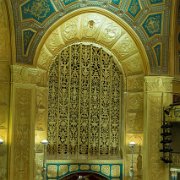
7 The Capitol Theatre was considered Detroit’s first official movie palace, and when it opened January 12, 1922, it sat about 3,500, the fifth largest ever built in the US at the time.
Its architect, C. Howard Crane, designed the Capitol Theatre in the style of the Italian Renaissance, and its facade, with its soaring Corinthian columns, loomed over Broadway like a royal palace. Its interior was even more ornate, with several kinds of marble, Tiffany mosaics, sculpture and gilt decorating its lobby and other areas. The Capitol Theatre is said to have cost over $2 million to build.
The 35-piece ‘Great Capitol Wonder Orchestra’, led by Eduard Werner, was on hand opening day, and remained a popular feature of the theatre until he left the Capitol Theatre for the Michigan Theater in 1926. On screen, “The Lotus Eater” was shown, as well as footage of guests entering the theatre two hours earlier, much to the audience’s amazement and delight.
The theatre’s name was changed to the Paramount Theatre on August 30, 1929, when it was taken over by the Paramount-Publix chain, and featured live stage shows and vaudeville acts. Stars who appeared on the Paramount Theatre’s stage in those days included W.C. Fields, Fatty Arbuckle, and Guy Lombardo and his Orchestra.
As a result of the Depression, the theatre closed in 1932, but only until August31, 1934, when it reopened under United Detroit Theaters with another new name, this time the Broadway-Capitol Theatre.
In the 1940’s and 1950’s, management of the theatre passed back and forth between various parties, but it was managed by United Detroit Theaters once again beginning in 1960.
For most of the 1950’s, the Broadway-Capitol Theatre featured second-run films and double-features, and unlike many other area theatres, did not convert to the widescreen format to attract audiences.
It was in 1960 that United Detroit Theaters poured over $100,000 into remodeling the theatre, completely changing its facade and slightly reducing its seating capacity.
It was also given yet another new name during this time, the Grand Circus Theatre, continuing to screen second-run films. The theatre often struggled during the 1960’s and 1970’s, but remained open until 1978, with the last film on its screen being “Jailbait Babysitter”.
During the early-to-mid-1980’s, the Grand Circus Theatre was used for concerts, but was forced to close in 1985 after a fire broke out.
In 1989, the Michigan Opera Theatre purchased the Grand Circus Theatre and nearby Madison Theatre for $3.5 million and began a $20 million campaign to restore the interior of the old Capitol Theatre to its 1920’s appearance, enlarge its stage, improve the sound and lighting systems, and reduce seating to a more comfortable 2,700.
It now serves as the Detroit Opera House.
Its architect, C. Howard Crane, designed the Capitol Theatre in the style of the Italian Renaissance, and its facade, with its soaring Corinthian columns, loomed over Broadway like a royal palace. Its interior was even more ornate, with several kinds of marble, Tiffany mosaics, sculpture and gilt decorating its lobby and other areas. The Capitol Theatre is said to have cost over $2 million to build.
The 35-piece ‘Great Capitol Wonder Orchestra’, led by Eduard Werner, was on hand opening day, and remained a popular feature of the theatre until he left the Capitol Theatre for the Michigan Theater in 1926. On screen, “The Lotus Eater” was shown, as well as footage of guests entering the theatre two hours earlier, much to the audience’s amazement and delight.
The theatre’s name was changed to the Paramount Theatre on August 30, 1929, when it was taken over by the Paramount-Publix chain, and featured live stage shows and vaudeville acts. Stars who appeared on the Paramount Theatre’s stage in those days included W.C. Fields, Fatty Arbuckle, and Guy Lombardo and his Orchestra.
As a result of the Depression, the theatre closed in 1932, but only until August31, 1934, when it reopened under United Detroit Theaters with another new name, this time the Broadway-Capitol Theatre.
In the 1940’s and 1950’s, management of the theatre passed back and forth between various parties, but it was managed by United Detroit Theaters once again beginning in 1960.
For most of the 1950’s, the Broadway-Capitol Theatre featured second-run films and double-features, and unlike many other area theatres, did not convert to the widescreen format to attract audiences.
It was in 1960 that United Detroit Theaters poured over $100,000 into remodeling the theatre, completely changing its facade and slightly reducing its seating capacity.
It was also given yet another new name during this time, the Grand Circus Theatre, continuing to screen second-run films. The theatre often struggled during the 1960’s and 1970’s, but remained open until 1978, with the last film on its screen being “Jailbait Babysitter”.
During the early-to-mid-1980’s, the Grand Circus Theatre was used for concerts, but was forced to close in 1985 after a fire broke out.
In 1989, the Michigan Opera Theatre purchased the Grand Circus Theatre and nearby Madison Theatre for $3.5 million and began a $20 million campaign to restore the interior of the old Capitol Theatre to its 1920’s appearance, enlarge its stage, improve the sound and lighting systems, and reduce seating to a more comfortable 2,700.
It now serves as the Detroit Opera House.
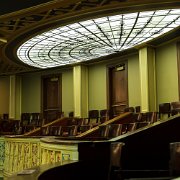
8 The Capitol Theatre was considered Detroit’s first official movie palace, and when it opened January 12, 1922, it sat about 3,500, the fifth largest ever built in the US at the time.
Its architect, C. Howard Crane, designed the Capitol Theatre in the style of the Italian Renaissance, and its facade, with its soaring Corinthian columns, loomed over Broadway like a royal palace. Its interior was even more ornate, with several kinds of marble, Tiffany mosaics, sculpture and gilt decorating its lobby and other areas. The Capitol Theatre is said to have cost over $2 million to build.
The 35-piece ‘Great Capitol Wonder Orchestra’, led by Eduard Werner, was on hand opening day, and remained a popular feature of the theatre until he left the Capitol Theatre for the Michigan Theater in 1926. On screen, “The Lotus Eater” was shown, as well as footage of guests entering the theatre two hours earlier, much to the audience’s amazement and delight.
The theatre’s name was changed to the Paramount Theatre on August 30, 1929, when it was taken over by the Paramount-Publix chain, and featured live stage shows and vaudeville acts. Stars who appeared on the Paramount Theatre’s stage in those days included W.C. Fields, Fatty Arbuckle, and Guy Lombardo and his Orchestra.
As a result of the Depression, the theatre closed in 1932, but only until August31, 1934, when it reopened under United Detroit Theaters with another new name, this time the Broadway-Capitol Theatre.
In the 1940’s and 1950’s, management of the theatre passed back and forth between various parties, but it was managed by United Detroit Theaters once again beginning in 1960.
For most of the 1950’s, the Broadway-Capitol Theatre featured second-run films and double-features, and unlike many other area theatres, did not convert to the widescreen format to attract audiences.
It was in 1960 that United Detroit Theaters poured over $100,000 into remodeling the theatre, completely changing its facade and slightly reducing its seating capacity.
It was also given yet another new name during this time, the Grand Circus Theatre, continuing to screen second-run films. The theatre often struggled during the 1960’s and 1970’s, but remained open until 1978, with the last film on its screen being “Jailbait Babysitter”.
During the early-to-mid-1980’s, the Grand Circus Theatre was used for concerts, but was forced to close in 1985 after a fire broke out.
In 1989, the Michigan Opera Theatre purchased the Grand Circus Theatre and nearby Madison Theatre for $3.5 million and began a $20 million campaign to restore the interior of the old Capitol Theatre to its 1920’s appearance, enlarge its stage, improve the sound and lighting systems, and reduce seating to a more comfortable 2,700.
It now serves as the Detroit Opera House.
Its architect, C. Howard Crane, designed the Capitol Theatre in the style of the Italian Renaissance, and its facade, with its soaring Corinthian columns, loomed over Broadway like a royal palace. Its interior was even more ornate, with several kinds of marble, Tiffany mosaics, sculpture and gilt decorating its lobby and other areas. The Capitol Theatre is said to have cost over $2 million to build.
The 35-piece ‘Great Capitol Wonder Orchestra’, led by Eduard Werner, was on hand opening day, and remained a popular feature of the theatre until he left the Capitol Theatre for the Michigan Theater in 1926. On screen, “The Lotus Eater” was shown, as well as footage of guests entering the theatre two hours earlier, much to the audience’s amazement and delight.
The theatre’s name was changed to the Paramount Theatre on August 30, 1929, when it was taken over by the Paramount-Publix chain, and featured live stage shows and vaudeville acts. Stars who appeared on the Paramount Theatre’s stage in those days included W.C. Fields, Fatty Arbuckle, and Guy Lombardo and his Orchestra.
As a result of the Depression, the theatre closed in 1932, but only until August31, 1934, when it reopened under United Detroit Theaters with another new name, this time the Broadway-Capitol Theatre.
In the 1940’s and 1950’s, management of the theatre passed back and forth between various parties, but it was managed by United Detroit Theaters once again beginning in 1960.
For most of the 1950’s, the Broadway-Capitol Theatre featured second-run films and double-features, and unlike many other area theatres, did not convert to the widescreen format to attract audiences.
It was in 1960 that United Detroit Theaters poured over $100,000 into remodeling the theatre, completely changing its facade and slightly reducing its seating capacity.
It was also given yet another new name during this time, the Grand Circus Theatre, continuing to screen second-run films. The theatre often struggled during the 1960’s and 1970’s, but remained open until 1978, with the last film on its screen being “Jailbait Babysitter”.
During the early-to-mid-1980’s, the Grand Circus Theatre was used for concerts, but was forced to close in 1985 after a fire broke out.
In 1989, the Michigan Opera Theatre purchased the Grand Circus Theatre and nearby Madison Theatre for $3.5 million and began a $20 million campaign to restore the interior of the old Capitol Theatre to its 1920’s appearance, enlarge its stage, improve the sound and lighting systems, and reduce seating to a more comfortable 2,700.
It now serves as the Detroit Opera House.
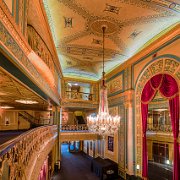
9 The Capitol Theatre was considered Detroit’s first official movie palace, and when it opened January 12, 1922, it sat about 3,500, the fifth largest ever built in the US at the time.
Its architect, C. Howard Crane, designed the Capitol Theatre in the style of the Italian Renaissance, and its facade, with its soaring Corinthian columns, loomed over Broadway like a royal palace. Its interior was even more ornate, with several kinds of marble, Tiffany mosaics, sculpture and gilt decorating its lobby and other areas. The Capitol Theatre is said to have cost over $2 million to build.
The 35-piece ‘Great Capitol Wonder Orchestra’, led by Eduard Werner, was on hand opening day, and remained a popular feature of the theatre until he left the Capitol Theatre for the Michigan Theater in 1926. On screen, “The Lotus Eater” was shown, as well as footage of guests entering the theatre two hours earlier, much to the audience’s amazement and delight.
The theatre’s name was changed to the Paramount Theatre on August 30, 1929, when it was taken over by the Paramount-Publix chain, and featured live stage shows and vaudeville acts. Stars who appeared on the Paramount Theatre’s stage in those days included W.C. Fields, Fatty Arbuckle, and Guy Lombardo and his Orchestra.
As a result of the Depression, the theatre closed in 1932, but only until August31, 1934, when it reopened under United Detroit Theaters with another new name, this time the Broadway-Capitol Theatre.
In the 1940’s and 1950’s, management of the theatre passed back and forth between various parties, but it was managed by United Detroit Theaters once again beginning in 1960.
For most of the 1950’s, the Broadway-Capitol Theatre featured second-run films and double-features, and unlike many other area theatres, did not convert to the widescreen format to attract audiences.
It was in 1960 that United Detroit Theaters poured over $100,000 into remodeling the theatre, completely changing its facade and slightly reducing its seating capacity.
It was also given yet another new name during this time, the Grand Circus Theatre, continuing to screen second-run films. The theatre often struggled during the 1960’s and 1970’s, but remained open until 1978, with the last film on its screen being “Jailbait Babysitter”.
During the early-to-mid-1980’s, the Grand Circus Theatre was used for concerts, but was forced to close in 1985 after a fire broke out.
In 1989, the Michigan Opera Theatre purchased the Grand Circus Theatre and nearby Madison Theatre for $3.5 million and began a $20 million campaign to restore the interior of the old Capitol Theatre to its 1920’s appearance, enlarge its stage, improve the sound and lighting systems, and reduce seating to a more comfortable 2,700.
It now serves as the Detroit Opera House.
Its architect, C. Howard Crane, designed the Capitol Theatre in the style of the Italian Renaissance, and its facade, with its soaring Corinthian columns, loomed over Broadway like a royal palace. Its interior was even more ornate, with several kinds of marble, Tiffany mosaics, sculpture and gilt decorating its lobby and other areas. The Capitol Theatre is said to have cost over $2 million to build.
The 35-piece ‘Great Capitol Wonder Orchestra’, led by Eduard Werner, was on hand opening day, and remained a popular feature of the theatre until he left the Capitol Theatre for the Michigan Theater in 1926. On screen, “The Lotus Eater” was shown, as well as footage of guests entering the theatre two hours earlier, much to the audience’s amazement and delight.
The theatre’s name was changed to the Paramount Theatre on August 30, 1929, when it was taken over by the Paramount-Publix chain, and featured live stage shows and vaudeville acts. Stars who appeared on the Paramount Theatre’s stage in those days included W.C. Fields, Fatty Arbuckle, and Guy Lombardo and his Orchestra.
As a result of the Depression, the theatre closed in 1932, but only until August31, 1934, when it reopened under United Detroit Theaters with another new name, this time the Broadway-Capitol Theatre.
In the 1940’s and 1950’s, management of the theatre passed back and forth between various parties, but it was managed by United Detroit Theaters once again beginning in 1960.
For most of the 1950’s, the Broadway-Capitol Theatre featured second-run films and double-features, and unlike many other area theatres, did not convert to the widescreen format to attract audiences.
It was in 1960 that United Detroit Theaters poured over $100,000 into remodeling the theatre, completely changing its facade and slightly reducing its seating capacity.
It was also given yet another new name during this time, the Grand Circus Theatre, continuing to screen second-run films. The theatre often struggled during the 1960’s and 1970’s, but remained open until 1978, with the last film on its screen being “Jailbait Babysitter”.
During the early-to-mid-1980’s, the Grand Circus Theatre was used for concerts, but was forced to close in 1985 after a fire broke out.
In 1989, the Michigan Opera Theatre purchased the Grand Circus Theatre and nearby Madison Theatre for $3.5 million and began a $20 million campaign to restore the interior of the old Capitol Theatre to its 1920’s appearance, enlarge its stage, improve the sound and lighting systems, and reduce seating to a more comfortable 2,700.
It now serves as the Detroit Opera House.
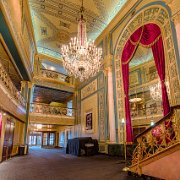
10 The Capitol Theatre was considered Detroit’s first official movie palace, and when it opened January 12, 1922, it sat about 3,500, the fifth largest ever built in the US at the time.
Its architect, C. Howard Crane, designed the Capitol Theatre in the style of the Italian Renaissance, and its facade, with its soaring Corinthian columns, loomed over Broadway like a royal palace. Its interior was even more ornate, with several kinds of marble, Tiffany mosaics, sculpture and gilt decorating its lobby and other areas. The Capitol Theatre is said to have cost over $2 million to build.
The 35-piece ‘Great Capitol Wonder Orchestra’, led by Eduard Werner, was on hand opening day, and remained a popular feature of the theatre until he left the Capitol Theatre for the Michigan Theater in 1926. On screen, “The Lotus Eater” was shown, as well as footage of guests entering the theatre two hours earlier, much to the audience’s amazement and delight.
The theatre’s name was changed to the Paramount Theatre on August 30, 1929, when it was taken over by the Paramount-Publix chain, and featured live stage shows and vaudeville acts. Stars who appeared on the Paramount Theatre’s stage in those days included W.C. Fields, Fatty Arbuckle, and Guy Lombardo and his Orchestra.
As a result of the Depression, the theatre closed in 1932, but only until August31, 1934, when it reopened under United Detroit Theaters with another new name, this time the Broadway-Capitol Theatre.
In the 1940’s and 1950’s, management of the theatre passed back and forth between various parties, but it was managed by United Detroit Theaters once again beginning in 1960.
For most of the 1950’s, the Broadway-Capitol Theatre featured second-run films and double-features, and unlike many other area theatres, did not convert to the widescreen format to attract audiences.
It was in 1960 that United Detroit Theaters poured over $100,000 into remodeling the theatre, completely changing its facade and slightly reducing its seating capacity.
It was also given yet another new name during this time, the Grand Circus Theatre, continuing to screen second-run films. The theatre often struggled during the 1960’s and 1970’s, but remained open until 1978, with the last film on its screen being “Jailbait Babysitter”.
During the early-to-mid-1980’s, the Grand Circus Theatre was used for concerts, but was forced to close in 1985 after a fire broke out.
In 1989, the Michigan Opera Theatre purchased the Grand Circus Theatre and nearby Madison Theatre for $3.5 million and began a $20 million campaign to restore the interior of the old Capitol Theatre to its 1920’s appearance, enlarge its stage, improve the sound and lighting systems, and reduce seating to a more comfortable 2,700.
It now serves as the Detroit Opera House.
Its architect, C. Howard Crane, designed the Capitol Theatre in the style of the Italian Renaissance, and its facade, with its soaring Corinthian columns, loomed over Broadway like a royal palace. Its interior was even more ornate, with several kinds of marble, Tiffany mosaics, sculpture and gilt decorating its lobby and other areas. The Capitol Theatre is said to have cost over $2 million to build.
The 35-piece ‘Great Capitol Wonder Orchestra’, led by Eduard Werner, was on hand opening day, and remained a popular feature of the theatre until he left the Capitol Theatre for the Michigan Theater in 1926. On screen, “The Lotus Eater” was shown, as well as footage of guests entering the theatre two hours earlier, much to the audience’s amazement and delight.
The theatre’s name was changed to the Paramount Theatre on August 30, 1929, when it was taken over by the Paramount-Publix chain, and featured live stage shows and vaudeville acts. Stars who appeared on the Paramount Theatre’s stage in those days included W.C. Fields, Fatty Arbuckle, and Guy Lombardo and his Orchestra.
As a result of the Depression, the theatre closed in 1932, but only until August31, 1934, when it reopened under United Detroit Theaters with another new name, this time the Broadway-Capitol Theatre.
In the 1940’s and 1950’s, management of the theatre passed back and forth between various parties, but it was managed by United Detroit Theaters once again beginning in 1960.
For most of the 1950’s, the Broadway-Capitol Theatre featured second-run films and double-features, and unlike many other area theatres, did not convert to the widescreen format to attract audiences.
It was in 1960 that United Detroit Theaters poured over $100,000 into remodeling the theatre, completely changing its facade and slightly reducing its seating capacity.
It was also given yet another new name during this time, the Grand Circus Theatre, continuing to screen second-run films. The theatre often struggled during the 1960’s and 1970’s, but remained open until 1978, with the last film on its screen being “Jailbait Babysitter”.
During the early-to-mid-1980’s, the Grand Circus Theatre was used for concerts, but was forced to close in 1985 after a fire broke out.
In 1989, the Michigan Opera Theatre purchased the Grand Circus Theatre and nearby Madison Theatre for $3.5 million and began a $20 million campaign to restore the interior of the old Capitol Theatre to its 1920’s appearance, enlarge its stage, improve the sound and lighting systems, and reduce seating to a more comfortable 2,700.
It now serves as the Detroit Opera House.
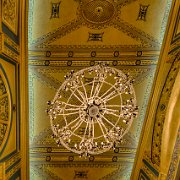
11 The Capitol Theatre was considered Detroit’s first official movie palace, and when it opened January 12, 1922, it sat about 3,500, the fifth largest ever built in the US at the time.
Its architect, C. Howard Crane, designed the Capitol Theatre in the style of the Italian Renaissance, and its facade, with its soaring Corinthian columns, loomed over Broadway like a royal palace. Its interior was even more ornate, with several kinds of marble, Tiffany mosaics, sculpture and gilt decorating its lobby and other areas. The Capitol Theatre is said to have cost over $2 million to build.
The 35-piece ‘Great Capitol Wonder Orchestra’, led by Eduard Werner, was on hand opening day, and remained a popular feature of the theatre until he left the Capitol Theatre for the Michigan Theater in 1926. On screen, “The Lotus Eater” was shown, as well as footage of guests entering the theatre two hours earlier, much to the audience’s amazement and delight.
The theatre’s name was changed to the Paramount Theatre on August 30, 1929, when it was taken over by the Paramount-Publix chain, and featured live stage shows and vaudeville acts. Stars who appeared on the Paramount Theatre’s stage in those days included W.C. Fields, Fatty Arbuckle, and Guy Lombardo and his Orchestra.
As a result of the Depression, the theatre closed in 1932, but only until August31, 1934, when it reopened under United Detroit Theaters with another new name, this time the Broadway-Capitol Theatre.
In the 1940’s and 1950’s, management of the theatre passed back and forth between various parties, but it was managed by United Detroit Theaters once again beginning in 1960.
For most of the 1950’s, the Broadway-Capitol Theatre featured second-run films and double-features, and unlike many other area theatres, did not convert to the widescreen format to attract audiences.
It was in 1960 that United Detroit Theaters poured over $100,000 into remodeling the theatre, completely changing its facade and slightly reducing its seating capacity.
It was also given yet another new name during this time, the Grand Circus Theatre, continuing to screen second-run films. The theatre often struggled during the 1960’s and 1970’s, but remained open until 1978, with the last film on its screen being “Jailbait Babysitter”.
During the early-to-mid-1980’s, the Grand Circus Theatre was used for concerts, but was forced to close in 1985 after a fire broke out.
In 1989, the Michigan Opera Theatre purchased the Grand Circus Theatre and nearby Madison Theatre for $3.5 million and began a $20 million campaign to restore the interior of the old Capitol Theatre to its 1920’s appearance, enlarge its stage, improve the sound and lighting systems, and reduce seating to a more comfortable 2,700.
It now serves as the Detroit Opera House.
Its architect, C. Howard Crane, designed the Capitol Theatre in the style of the Italian Renaissance, and its facade, with its soaring Corinthian columns, loomed over Broadway like a royal palace. Its interior was even more ornate, with several kinds of marble, Tiffany mosaics, sculpture and gilt decorating its lobby and other areas. The Capitol Theatre is said to have cost over $2 million to build.
The 35-piece ‘Great Capitol Wonder Orchestra’, led by Eduard Werner, was on hand opening day, and remained a popular feature of the theatre until he left the Capitol Theatre for the Michigan Theater in 1926. On screen, “The Lotus Eater” was shown, as well as footage of guests entering the theatre two hours earlier, much to the audience’s amazement and delight.
The theatre’s name was changed to the Paramount Theatre on August 30, 1929, when it was taken over by the Paramount-Publix chain, and featured live stage shows and vaudeville acts. Stars who appeared on the Paramount Theatre’s stage in those days included W.C. Fields, Fatty Arbuckle, and Guy Lombardo and his Orchestra.
As a result of the Depression, the theatre closed in 1932, but only until August31, 1934, when it reopened under United Detroit Theaters with another new name, this time the Broadway-Capitol Theatre.
In the 1940’s and 1950’s, management of the theatre passed back and forth between various parties, but it was managed by United Detroit Theaters once again beginning in 1960.
For most of the 1950’s, the Broadway-Capitol Theatre featured second-run films and double-features, and unlike many other area theatres, did not convert to the widescreen format to attract audiences.
It was in 1960 that United Detroit Theaters poured over $100,000 into remodeling the theatre, completely changing its facade and slightly reducing its seating capacity.
It was also given yet another new name during this time, the Grand Circus Theatre, continuing to screen second-run films. The theatre often struggled during the 1960’s and 1970’s, but remained open until 1978, with the last film on its screen being “Jailbait Babysitter”.
During the early-to-mid-1980’s, the Grand Circus Theatre was used for concerts, but was forced to close in 1985 after a fire broke out.
In 1989, the Michigan Opera Theatre purchased the Grand Circus Theatre and nearby Madison Theatre for $3.5 million and began a $20 million campaign to restore the interior of the old Capitol Theatre to its 1920’s appearance, enlarge its stage, improve the sound and lighting systems, and reduce seating to a more comfortable 2,700.
It now serves as the Detroit Opera House.
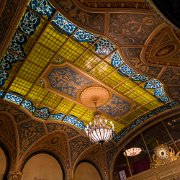
12 The Capitol Theatre was considered Detroit’s first official movie palace, and when it opened January 12, 1922, it sat about 3,500, the fifth largest ever built in the US at the time.
Its architect, C. Howard Crane, designed the Capitol Theatre in the style of the Italian Renaissance, and its facade, with its soaring Corinthian columns, loomed over Broadway like a royal palace. Its interior was even more ornate, with several kinds of marble, Tiffany mosaics, sculpture and gilt decorating its lobby and other areas. The Capitol Theatre is said to have cost over $2 million to build.
The 35-piece ‘Great Capitol Wonder Orchestra’, led by Eduard Werner, was on hand opening day, and remained a popular feature of the theatre until he left the Capitol Theatre for the Michigan Theater in 1926. On screen, “The Lotus Eater” was shown, as well as footage of guests entering the theatre two hours earlier, much to the audience’s amazement and delight.
The theatre’s name was changed to the Paramount Theatre on August 30, 1929, when it was taken over by the Paramount-Publix chain, and featured live stage shows and vaudeville acts. Stars who appeared on the Paramount Theatre’s stage in those days included W.C. Fields, Fatty Arbuckle, and Guy Lombardo and his Orchestra.
As a result of the Depression, the theatre closed in 1932, but only until August31, 1934, when it reopened under United Detroit Theaters with another new name, this time the Broadway-Capitol Theatre.
In the 1940’s and 1950’s, management of the theatre passed back and forth between various parties, but it was managed by United Detroit Theaters once again beginning in 1960.
For most of the 1950’s, the Broadway-Capitol Theatre featured second-run films and double-features, and unlike many other area theatres, did not convert to the widescreen format to attract audiences.
It was in 1960 that United Detroit Theaters poured over $100,000 into remodeling the theatre, completely changing its facade and slightly reducing its seating capacity.
It was also given yet another new name during this time, the Grand Circus Theatre, continuing to screen second-run films. The theatre often struggled during the 1960’s and 1970’s, but remained open until 1978, with the last film on its screen being “Jailbait Babysitter”.
During the early-to-mid-1980’s, the Grand Circus Theatre was used for concerts, but was forced to close in 1985 after a fire broke out.
In 1989, the Michigan Opera Theatre purchased the Grand Circus Theatre and nearby Madison Theatre for $3.5 million and began a $20 million campaign to restore the interior of the old Capitol Theatre to its 1920’s appearance, enlarge its stage, improve the sound and lighting systems, and reduce seating to a more comfortable 2,700.
It now serves as the Detroit Opera House.
Its architect, C. Howard Crane, designed the Capitol Theatre in the style of the Italian Renaissance, and its facade, with its soaring Corinthian columns, loomed over Broadway like a royal palace. Its interior was even more ornate, with several kinds of marble, Tiffany mosaics, sculpture and gilt decorating its lobby and other areas. The Capitol Theatre is said to have cost over $2 million to build.
The 35-piece ‘Great Capitol Wonder Orchestra’, led by Eduard Werner, was on hand opening day, and remained a popular feature of the theatre until he left the Capitol Theatre for the Michigan Theater in 1926. On screen, “The Lotus Eater” was shown, as well as footage of guests entering the theatre two hours earlier, much to the audience’s amazement and delight.
The theatre’s name was changed to the Paramount Theatre on August 30, 1929, when it was taken over by the Paramount-Publix chain, and featured live stage shows and vaudeville acts. Stars who appeared on the Paramount Theatre’s stage in those days included W.C. Fields, Fatty Arbuckle, and Guy Lombardo and his Orchestra.
As a result of the Depression, the theatre closed in 1932, but only until August31, 1934, when it reopened under United Detroit Theaters with another new name, this time the Broadway-Capitol Theatre.
In the 1940’s and 1950’s, management of the theatre passed back and forth between various parties, but it was managed by United Detroit Theaters once again beginning in 1960.
For most of the 1950’s, the Broadway-Capitol Theatre featured second-run films and double-features, and unlike many other area theatres, did not convert to the widescreen format to attract audiences.
It was in 1960 that United Detroit Theaters poured over $100,000 into remodeling the theatre, completely changing its facade and slightly reducing its seating capacity.
It was also given yet another new name during this time, the Grand Circus Theatre, continuing to screen second-run films. The theatre often struggled during the 1960’s and 1970’s, but remained open until 1978, with the last film on its screen being “Jailbait Babysitter”.
During the early-to-mid-1980’s, the Grand Circus Theatre was used for concerts, but was forced to close in 1985 after a fire broke out.
In 1989, the Michigan Opera Theatre purchased the Grand Circus Theatre and nearby Madison Theatre for $3.5 million and began a $20 million campaign to restore the interior of the old Capitol Theatre to its 1920’s appearance, enlarge its stage, improve the sound and lighting systems, and reduce seating to a more comfortable 2,700.
It now serves as the Detroit Opera House.
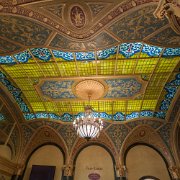
13 The Capitol Theatre was considered Detroit’s first official movie palace, and when it opened January 12, 1922, it sat about 3,500, the fifth largest ever built in the US at the time.
Its architect, C. Howard Crane, designed the Capitol Theatre in the style of the Italian Renaissance, and its facade, with its soaring Corinthian columns, loomed over Broadway like a royal palace. Its interior was even more ornate, with several kinds of marble, Tiffany mosaics, sculpture and gilt decorating its lobby and other areas. The Capitol Theatre is said to have cost over $2 million to build.
The 35-piece ‘Great Capitol Wonder Orchestra’, led by Eduard Werner, was on hand opening day, and remained a popular feature of the theatre until he left the Capitol Theatre for the Michigan Theater in 1926. On screen, “The Lotus Eater” was shown, as well as footage of guests entering the theatre two hours earlier, much to the audience’s amazement and delight.
The theatre’s name was changed to the Paramount Theatre on August 30, 1929, when it was taken over by the Paramount-Publix chain, and featured live stage shows and vaudeville acts. Stars who appeared on the Paramount Theatre’s stage in those days included W.C. Fields, Fatty Arbuckle, and Guy Lombardo and his Orchestra.
As a result of the Depression, the theatre closed in 1932, but only until August31, 1934, when it reopened under United Detroit Theaters with another new name, this time the Broadway-Capitol Theatre.
In the 1940’s and 1950’s, management of the theatre passed back and forth between various parties, but it was managed by United Detroit Theaters once again beginning in 1960.
For most of the 1950’s, the Broadway-Capitol Theatre featured second-run films and double-features, and unlike many other area theatres, did not convert to the widescreen format to attract audiences.
It was in 1960 that United Detroit Theaters poured over $100,000 into remodeling the theatre, completely changing its facade and slightly reducing its seating capacity.
It was also given yet another new name during this time, the Grand Circus Theatre, continuing to screen second-run films. The theatre often struggled during the 1960’s and 1970’s, but remained open until 1978, with the last film on its screen being “Jailbait Babysitter”.
During the early-to-mid-1980’s, the Grand Circus Theatre was used for concerts, but was forced to close in 1985 after a fire broke out.
In 1989, the Michigan Opera Theatre purchased the Grand Circus Theatre and nearby Madison Theatre for $3.5 million and began a $20 million campaign to restore the interior of the old Capitol Theatre to its 1920’s appearance, enlarge its stage, improve the sound and lighting systems, and reduce seating to a more comfortable 2,700.
It now serves as the Detroit Opera House.
Its architect, C. Howard Crane, designed the Capitol Theatre in the style of the Italian Renaissance, and its facade, with its soaring Corinthian columns, loomed over Broadway like a royal palace. Its interior was even more ornate, with several kinds of marble, Tiffany mosaics, sculpture and gilt decorating its lobby and other areas. The Capitol Theatre is said to have cost over $2 million to build.
The 35-piece ‘Great Capitol Wonder Orchestra’, led by Eduard Werner, was on hand opening day, and remained a popular feature of the theatre until he left the Capitol Theatre for the Michigan Theater in 1926. On screen, “The Lotus Eater” was shown, as well as footage of guests entering the theatre two hours earlier, much to the audience’s amazement and delight.
The theatre’s name was changed to the Paramount Theatre on August 30, 1929, when it was taken over by the Paramount-Publix chain, and featured live stage shows and vaudeville acts. Stars who appeared on the Paramount Theatre’s stage in those days included W.C. Fields, Fatty Arbuckle, and Guy Lombardo and his Orchestra.
As a result of the Depression, the theatre closed in 1932, but only until August31, 1934, when it reopened under United Detroit Theaters with another new name, this time the Broadway-Capitol Theatre.
In the 1940’s and 1950’s, management of the theatre passed back and forth between various parties, but it was managed by United Detroit Theaters once again beginning in 1960.
For most of the 1950’s, the Broadway-Capitol Theatre featured second-run films and double-features, and unlike many other area theatres, did not convert to the widescreen format to attract audiences.
It was in 1960 that United Detroit Theaters poured over $100,000 into remodeling the theatre, completely changing its facade and slightly reducing its seating capacity.
It was also given yet another new name during this time, the Grand Circus Theatre, continuing to screen second-run films. The theatre often struggled during the 1960’s and 1970’s, but remained open until 1978, with the last film on its screen being “Jailbait Babysitter”.
During the early-to-mid-1980’s, the Grand Circus Theatre was used for concerts, but was forced to close in 1985 after a fire broke out.
In 1989, the Michigan Opera Theatre purchased the Grand Circus Theatre and nearby Madison Theatre for $3.5 million and began a $20 million campaign to restore the interior of the old Capitol Theatre to its 1920’s appearance, enlarge its stage, improve the sound and lighting systems, and reduce seating to a more comfortable 2,700.
It now serves as the Detroit Opera House.
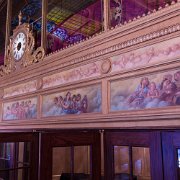
14 The Capitol Theatre was considered Detroit’s first official movie palace, and when it opened January 12, 1922, it sat about 3,500, the fifth largest ever built in the US at the time.
Its architect, C. Howard Crane, designed the Capitol Theatre in the style of the Italian Renaissance, and its facade, with its soaring Corinthian columns, loomed over Broadway like a royal palace. Its interior was even more ornate, with several kinds of marble, Tiffany mosaics, sculpture and gilt decorating its lobby and other areas. The Capitol Theatre is said to have cost over $2 million to build.
The 35-piece ‘Great Capitol Wonder Orchestra’, led by Eduard Werner, was on hand opening day, and remained a popular feature of the theatre until he left the Capitol Theatre for the Michigan Theater in 1926. On screen, “The Lotus Eater” was shown, as well as footage of guests entering the theatre two hours earlier, much to the audience’s amazement and delight.
The theatre’s name was changed to the Paramount Theatre on August 30, 1929, when it was taken over by the Paramount-Publix chain, and featured live stage shows and vaudeville acts. Stars who appeared on the Paramount Theatre’s stage in those days included W.C. Fields, Fatty Arbuckle, and Guy Lombardo and his Orchestra.
As a result of the Depression, the theatre closed in 1932, but only until August31, 1934, when it reopened under United Detroit Theaters with another new name, this time the Broadway-Capitol Theatre.
In the 1940’s and 1950’s, management of the theatre passed back and forth between various parties, but it was managed by United Detroit Theaters once again beginning in 1960.
For most of the 1950’s, the Broadway-Capitol Theatre featured second-run films and double-features, and unlike many other area theatres, did not convert to the widescreen format to attract audiences.
It was in 1960 that United Detroit Theaters poured over $100,000 into remodeling the theatre, completely changing its facade and slightly reducing its seating capacity.
It was also given yet another new name during this time, the Grand Circus Theatre, continuing to screen second-run films. The theatre often struggled during the 1960’s and 1970’s, but remained open until 1978, with the last film on its screen being “Jailbait Babysitter”.
During the early-to-mid-1980’s, the Grand Circus Theatre was used for concerts, but was forced to close in 1985 after a fire broke out.
In 1989, the Michigan Opera Theatre purchased the Grand Circus Theatre and nearby Madison Theatre for $3.5 million and began a $20 million campaign to restore the interior of the old Capitol Theatre to its 1920’s appearance, enlarge its stage, improve the sound and lighting systems, and reduce seating to a more comfortable 2,700.
It now serves as the Detroit Opera House.
Its architect, C. Howard Crane, designed the Capitol Theatre in the style of the Italian Renaissance, and its facade, with its soaring Corinthian columns, loomed over Broadway like a royal palace. Its interior was even more ornate, with several kinds of marble, Tiffany mosaics, sculpture and gilt decorating its lobby and other areas. The Capitol Theatre is said to have cost over $2 million to build.
The 35-piece ‘Great Capitol Wonder Orchestra’, led by Eduard Werner, was on hand opening day, and remained a popular feature of the theatre until he left the Capitol Theatre for the Michigan Theater in 1926. On screen, “The Lotus Eater” was shown, as well as footage of guests entering the theatre two hours earlier, much to the audience’s amazement and delight.
The theatre’s name was changed to the Paramount Theatre on August 30, 1929, when it was taken over by the Paramount-Publix chain, and featured live stage shows and vaudeville acts. Stars who appeared on the Paramount Theatre’s stage in those days included W.C. Fields, Fatty Arbuckle, and Guy Lombardo and his Orchestra.
As a result of the Depression, the theatre closed in 1932, but only until August31, 1934, when it reopened under United Detroit Theaters with another new name, this time the Broadway-Capitol Theatre.
In the 1940’s and 1950’s, management of the theatre passed back and forth between various parties, but it was managed by United Detroit Theaters once again beginning in 1960.
For most of the 1950’s, the Broadway-Capitol Theatre featured second-run films and double-features, and unlike many other area theatres, did not convert to the widescreen format to attract audiences.
It was in 1960 that United Detroit Theaters poured over $100,000 into remodeling the theatre, completely changing its facade and slightly reducing its seating capacity.
It was also given yet another new name during this time, the Grand Circus Theatre, continuing to screen second-run films. The theatre often struggled during the 1960’s and 1970’s, but remained open until 1978, with the last film on its screen being “Jailbait Babysitter”.
During the early-to-mid-1980’s, the Grand Circus Theatre was used for concerts, but was forced to close in 1985 after a fire broke out.
In 1989, the Michigan Opera Theatre purchased the Grand Circus Theatre and nearby Madison Theatre for $3.5 million and began a $20 million campaign to restore the interior of the old Capitol Theatre to its 1920’s appearance, enlarge its stage, improve the sound and lighting systems, and reduce seating to a more comfortable 2,700.
It now serves as the Detroit Opera House.
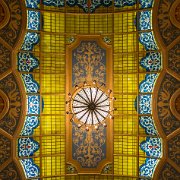
15 The Capitol Theatre was considered Detroit’s first official movie palace, and when it opened January 12, 1922, it sat about 3,500, the fifth largest ever built in the US at the time.
Its architect, C. Howard Crane, designed the Capitol Theatre in the style of the Italian Renaissance, and its facade, with its soaring Corinthian columns, loomed over Broadway like a royal palace. Its interior was even more ornate, with several kinds of marble, Tiffany mosaics, sculpture and gilt decorating its lobby and other areas. The Capitol Theatre is said to have cost over $2 million to build.
The 35-piece ‘Great Capitol Wonder Orchestra’, led by Eduard Werner, was on hand opening day, and remained a popular feature of the theatre until he left the Capitol Theatre for the Michigan Theater in 1926. On screen, “The Lotus Eater” was shown, as well as footage of guests entering the theatre two hours earlier, much to the audience’s amazement and delight.
The theatre’s name was changed to the Paramount Theatre on August 30, 1929, when it was taken over by the Paramount-Publix chain, and featured live stage shows and vaudeville acts. Stars who appeared on the Paramount Theatre’s stage in those days included W.C. Fields, Fatty Arbuckle, and Guy Lombardo and his Orchestra.
As a result of the Depression, the theatre closed in 1932, but only until August31, 1934, when it reopened under United Detroit Theaters with another new name, this time the Broadway-Capitol Theatre.
In the 1940’s and 1950’s, management of the theatre passed back and forth between various parties, but it was managed by United Detroit Theaters once again beginning in 1960.
For most of the 1950’s, the Broadway-Capitol Theatre featured second-run films and double-features, and unlike many other area theatres, did not convert to the widescreen format to attract audiences.
It was in 1960 that United Detroit Theaters poured over $100,000 into remodeling the theatre, completely changing its facade and slightly reducing its seating capacity.
It was also given yet another new name during this time, the Grand Circus Theatre, continuing to screen second-run films. The theatre often struggled during the 1960’s and 1970’s, but remained open until 1978, with the last film on its screen being “Jailbait Babysitter”.
During the early-to-mid-1980’s, the Grand Circus Theatre was used for concerts, but was forced to close in 1985 after a fire broke out.
In 1989, the Michigan Opera Theatre purchased the Grand Circus Theatre and nearby Madison Theatre for $3.5 million and began a $20 million campaign to restore the interior of the old Capitol Theatre to its 1920’s appearance, enlarge its stage, improve the sound and lighting systems, and reduce seating to a more comfortable 2,700.
It now serves as the Detroit Opera House.
Its architect, C. Howard Crane, designed the Capitol Theatre in the style of the Italian Renaissance, and its facade, with its soaring Corinthian columns, loomed over Broadway like a royal palace. Its interior was even more ornate, with several kinds of marble, Tiffany mosaics, sculpture and gilt decorating its lobby and other areas. The Capitol Theatre is said to have cost over $2 million to build.
The 35-piece ‘Great Capitol Wonder Orchestra’, led by Eduard Werner, was on hand opening day, and remained a popular feature of the theatre until he left the Capitol Theatre for the Michigan Theater in 1926. On screen, “The Lotus Eater” was shown, as well as footage of guests entering the theatre two hours earlier, much to the audience’s amazement and delight.
The theatre’s name was changed to the Paramount Theatre on August 30, 1929, when it was taken over by the Paramount-Publix chain, and featured live stage shows and vaudeville acts. Stars who appeared on the Paramount Theatre’s stage in those days included W.C. Fields, Fatty Arbuckle, and Guy Lombardo and his Orchestra.
As a result of the Depression, the theatre closed in 1932, but only until August31, 1934, when it reopened under United Detroit Theaters with another new name, this time the Broadway-Capitol Theatre.
In the 1940’s and 1950’s, management of the theatre passed back and forth between various parties, but it was managed by United Detroit Theaters once again beginning in 1960.
For most of the 1950’s, the Broadway-Capitol Theatre featured second-run films and double-features, and unlike many other area theatres, did not convert to the widescreen format to attract audiences.
It was in 1960 that United Detroit Theaters poured over $100,000 into remodeling the theatre, completely changing its facade and slightly reducing its seating capacity.
It was also given yet another new name during this time, the Grand Circus Theatre, continuing to screen second-run films. The theatre often struggled during the 1960’s and 1970’s, but remained open until 1978, with the last film on its screen being “Jailbait Babysitter”.
During the early-to-mid-1980’s, the Grand Circus Theatre was used for concerts, but was forced to close in 1985 after a fire broke out.
In 1989, the Michigan Opera Theatre purchased the Grand Circus Theatre and nearby Madison Theatre for $3.5 million and began a $20 million campaign to restore the interior of the old Capitol Theatre to its 1920’s appearance, enlarge its stage, improve the sound and lighting systems, and reduce seating to a more comfortable 2,700.
It now serves as the Detroit Opera House.
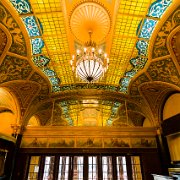
16 The Capitol Theatre was considered Detroit’s first official movie palace, and when it opened January 12, 1922, it sat about 3,500, the fifth largest ever built in the US at the time.
Its architect, C. Howard Crane, designed the Capitol Theatre in the style of the Italian Renaissance, and its facade, with its soaring Corinthian columns, loomed over Broadway like a royal palace. Its interior was even more ornate, with several kinds of marble, Tiffany mosaics, sculpture and gilt decorating its lobby and other areas. The Capitol Theatre is said to have cost over $2 million to build.
The 35-piece ‘Great Capitol Wonder Orchestra’, led by Eduard Werner, was on hand opening day, and remained a popular feature of the theatre until he left the Capitol Theatre for the Michigan Theater in 1926. On screen, “The Lotus Eater” was shown, as well as footage of guests entering the theatre two hours earlier, much to the audience’s amazement and delight.
The theatre’s name was changed to the Paramount Theatre on August 30, 1929, when it was taken over by the Paramount-Publix chain, and featured live stage shows and vaudeville acts. Stars who appeared on the Paramount Theatre’s stage in those days included W.C. Fields, Fatty Arbuckle, and Guy Lombardo and his Orchestra.
As a result of the Depression, the theatre closed in 1932, but only until August31, 1934, when it reopened under United Detroit Theaters with another new name, this time the Broadway-Capitol Theatre.
In the 1940’s and 1950’s, management of the theatre passed back and forth between various parties, but it was managed by United Detroit Theaters once again beginning in 1960.
For most of the 1950’s, the Broadway-Capitol Theatre featured second-run films and double-features, and unlike many other area theatres, did not convert to the widescreen format to attract audiences.
It was in 1960 that United Detroit Theaters poured over $100,000 into remodeling the theatre, completely changing its facade and slightly reducing its seating capacity.
It was also given yet another new name during this time, the Grand Circus Theatre, continuing to screen second-run films. The theatre often struggled during the 1960’s and 1970’s, but remained open until 1978, with the last film on its screen being “Jailbait Babysitter”.
During the early-to-mid-1980’s, the Grand Circus Theatre was used for concerts, but was forced to close in 1985 after a fire broke out.
In 1989, the Michigan Opera Theatre purchased the Grand Circus Theatre and nearby Madison Theatre for $3.5 million and began a $20 million campaign to restore the interior of the old Capitol Theatre to its 1920’s appearance, enlarge its stage, improve the sound and lighting systems, and reduce seating to a more comfortable 2,700.
It now serves as the Detroit Opera House.
Its architect, C. Howard Crane, designed the Capitol Theatre in the style of the Italian Renaissance, and its facade, with its soaring Corinthian columns, loomed over Broadway like a royal palace. Its interior was even more ornate, with several kinds of marble, Tiffany mosaics, sculpture and gilt decorating its lobby and other areas. The Capitol Theatre is said to have cost over $2 million to build.
The 35-piece ‘Great Capitol Wonder Orchestra’, led by Eduard Werner, was on hand opening day, and remained a popular feature of the theatre until he left the Capitol Theatre for the Michigan Theater in 1926. On screen, “The Lotus Eater” was shown, as well as footage of guests entering the theatre two hours earlier, much to the audience’s amazement and delight.
The theatre’s name was changed to the Paramount Theatre on August 30, 1929, when it was taken over by the Paramount-Publix chain, and featured live stage shows and vaudeville acts. Stars who appeared on the Paramount Theatre’s stage in those days included W.C. Fields, Fatty Arbuckle, and Guy Lombardo and his Orchestra.
As a result of the Depression, the theatre closed in 1932, but only until August31, 1934, when it reopened under United Detroit Theaters with another new name, this time the Broadway-Capitol Theatre.
In the 1940’s and 1950’s, management of the theatre passed back and forth between various parties, but it was managed by United Detroit Theaters once again beginning in 1960.
For most of the 1950’s, the Broadway-Capitol Theatre featured second-run films and double-features, and unlike many other area theatres, did not convert to the widescreen format to attract audiences.
It was in 1960 that United Detroit Theaters poured over $100,000 into remodeling the theatre, completely changing its facade and slightly reducing its seating capacity.
It was also given yet another new name during this time, the Grand Circus Theatre, continuing to screen second-run films. The theatre often struggled during the 1960’s and 1970’s, but remained open until 1978, with the last film on its screen being “Jailbait Babysitter”.
During the early-to-mid-1980’s, the Grand Circus Theatre was used for concerts, but was forced to close in 1985 after a fire broke out.
In 1989, the Michigan Opera Theatre purchased the Grand Circus Theatre and nearby Madison Theatre for $3.5 million and began a $20 million campaign to restore the interior of the old Capitol Theatre to its 1920’s appearance, enlarge its stage, improve the sound and lighting systems, and reduce seating to a more comfortable 2,700.
It now serves as the Detroit Opera House.
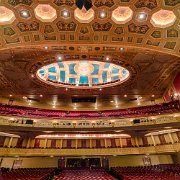
17 The Capitol Theatre was considered Detroit’s first official movie palace, and when it opened January 12, 1922, it sat about 3,500, the fifth largest ever built in the US at the time.
Its architect, C. Howard Crane, designed the Capitol Theatre in the style of the Italian Renaissance, and its facade, with its soaring Corinthian columns, loomed over Broadway like a royal palace. Its interior was even more ornate, with several kinds of marble, Tiffany mosaics, sculpture and gilt decorating its lobby and other areas. The Capitol Theatre is said to have cost over $2 million to build.
The 35-piece ‘Great Capitol Wonder Orchestra’, led by Eduard Werner, was on hand opening day, and remained a popular feature of the theatre until he left the Capitol Theatre for the Michigan Theater in 1926. On screen, “The Lotus Eater” was shown, as well as footage of guests entering the theatre two hours earlier, much to the audience’s amazement and delight.
The theatre’s name was changed to the Paramount Theatre on August 30, 1929, when it was taken over by the Paramount-Publix chain, and featured live stage shows and vaudeville acts. Stars who appeared on the Paramount Theatre’s stage in those days included W.C. Fields, Fatty Arbuckle, and Guy Lombardo and his Orchestra.
As a result of the Depression, the theatre closed in 1932, but only until August31, 1934, when it reopened under United Detroit Theaters with another new name, this time the Broadway-Capitol Theatre.
In the 1940’s and 1950’s, management of the theatre passed back and forth between various parties, but it was managed by United Detroit Theaters once again beginning in 1960.
For most of the 1950’s, the Broadway-Capitol Theatre featured second-run films and double-features, and unlike many other area theatres, did not convert to the widescreen format to attract audiences.
It was in 1960 that United Detroit Theaters poured over $100,000 into remodeling the theatre, completely changing its facade and slightly reducing its seating capacity.
It was also given yet another new name during this time, the Grand Circus Theatre, continuing to screen second-run films. The theatre often struggled during the 1960’s and 1970’s, but remained open until 1978, with the last film on its screen being “Jailbait Babysitter”.
During the early-to-mid-1980’s, the Grand Circus Theatre was used for concerts, but was forced to close in 1985 after a fire broke out.
In 1989, the Michigan Opera Theatre purchased the Grand Circus Theatre and nearby Madison Theatre for $3.5 million and began a $20 million campaign to restore the interior of the old Capitol Theatre to its 1920’s appearance, enlarge its stage, improve the sound and lighting systems, and reduce seating to a more comfortable 2,700.
It now serves as the Detroit Opera House.
Its architect, C. Howard Crane, designed the Capitol Theatre in the style of the Italian Renaissance, and its facade, with its soaring Corinthian columns, loomed over Broadway like a royal palace. Its interior was even more ornate, with several kinds of marble, Tiffany mosaics, sculpture and gilt decorating its lobby and other areas. The Capitol Theatre is said to have cost over $2 million to build.
The 35-piece ‘Great Capitol Wonder Orchestra’, led by Eduard Werner, was on hand opening day, and remained a popular feature of the theatre until he left the Capitol Theatre for the Michigan Theater in 1926. On screen, “The Lotus Eater” was shown, as well as footage of guests entering the theatre two hours earlier, much to the audience’s amazement and delight.
The theatre’s name was changed to the Paramount Theatre on August 30, 1929, when it was taken over by the Paramount-Publix chain, and featured live stage shows and vaudeville acts. Stars who appeared on the Paramount Theatre’s stage in those days included W.C. Fields, Fatty Arbuckle, and Guy Lombardo and his Orchestra.
As a result of the Depression, the theatre closed in 1932, but only until August31, 1934, when it reopened under United Detroit Theaters with another new name, this time the Broadway-Capitol Theatre.
In the 1940’s and 1950’s, management of the theatre passed back and forth between various parties, but it was managed by United Detroit Theaters once again beginning in 1960.
For most of the 1950’s, the Broadway-Capitol Theatre featured second-run films and double-features, and unlike many other area theatres, did not convert to the widescreen format to attract audiences.
It was in 1960 that United Detroit Theaters poured over $100,000 into remodeling the theatre, completely changing its facade and slightly reducing its seating capacity.
It was also given yet another new name during this time, the Grand Circus Theatre, continuing to screen second-run films. The theatre often struggled during the 1960’s and 1970’s, but remained open until 1978, with the last film on its screen being “Jailbait Babysitter”.
During the early-to-mid-1980’s, the Grand Circus Theatre was used for concerts, but was forced to close in 1985 after a fire broke out.
In 1989, the Michigan Opera Theatre purchased the Grand Circus Theatre and nearby Madison Theatre for $3.5 million and began a $20 million campaign to restore the interior of the old Capitol Theatre to its 1920’s appearance, enlarge its stage, improve the sound and lighting systems, and reduce seating to a more comfortable 2,700.
It now serves as the Detroit Opera House.
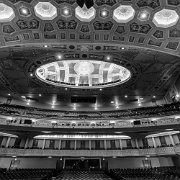
18 The Capitol Theatre was considered Detroit’s first official movie palace, and when it opened January 12, 1922, it sat about 3,500, the fifth largest ever built in the US at the time.
Its architect, C. Howard Crane, designed the Capitol Theatre in the style of the Italian Renaissance, and its facade, with its soaring Corinthian columns, loomed over Broadway like a royal palace. Its interior was even more ornate, with several kinds of marble, Tiffany mosaics, sculpture and gilt decorating its lobby and other areas. The Capitol Theatre is said to have cost over $2 million to build.
The 35-piece ‘Great Capitol Wonder Orchestra’, led by Eduard Werner, was on hand opening day, and remained a popular feature of the theatre until he left the Capitol Theatre for the Michigan Theater in 1926. On screen, “The Lotus Eater” was shown, as well as footage of guests entering the theatre two hours earlier, much to the audience’s amazement and delight.
The theatre’s name was changed to the Paramount Theatre on August 30, 1929, when it was taken over by the Paramount-Publix chain, and featured live stage shows and vaudeville acts. Stars who appeared on the Paramount Theatre’s stage in those days included W.C. Fields, Fatty Arbuckle, and Guy Lombardo and his Orchestra.
As a result of the Depression, the theatre closed in 1932, but only until August31, 1934, when it reopened under United Detroit Theaters with another new name, this time the Broadway-Capitol Theatre.
In the 1940’s and 1950’s, management of the theatre passed back and forth between various parties, but it was managed by United Detroit Theaters once again beginning in 1960.
For most of the 1950’s, the Broadway-Capitol Theatre featured second-run films and double-features, and unlike many other area theatres, did not convert to the widescreen format to attract audiences.
It was in 1960 that United Detroit Theaters poured over $100,000 into remodeling the theatre, completely changing its facade and slightly reducing its seating capacity.
It was also given yet another new name during this time, the Grand Circus Theatre, continuing to screen second-run films. The theatre often struggled during the 1960’s and 1970’s, but remained open until 1978, with the last film on its screen being “Jailbait Babysitter”.
During the early-to-mid-1980’s, the Grand Circus Theatre was used for concerts, but was forced to close in 1985 after a fire broke out.
In 1989, the Michigan Opera Theatre purchased the Grand Circus Theatre and nearby Madison Theatre for $3.5 million and began a $20 million campaign to restore the interior of the old Capitol Theatre to its 1920’s appearance, enlarge its stage, improve the sound and lighting systems, and reduce seating to a more comfortable 2,700.
It now serves as the Detroit Opera House.
Its architect, C. Howard Crane, designed the Capitol Theatre in the style of the Italian Renaissance, and its facade, with its soaring Corinthian columns, loomed over Broadway like a royal palace. Its interior was even more ornate, with several kinds of marble, Tiffany mosaics, sculpture and gilt decorating its lobby and other areas. The Capitol Theatre is said to have cost over $2 million to build.
The 35-piece ‘Great Capitol Wonder Orchestra’, led by Eduard Werner, was on hand opening day, and remained a popular feature of the theatre until he left the Capitol Theatre for the Michigan Theater in 1926. On screen, “The Lotus Eater” was shown, as well as footage of guests entering the theatre two hours earlier, much to the audience’s amazement and delight.
The theatre’s name was changed to the Paramount Theatre on August 30, 1929, when it was taken over by the Paramount-Publix chain, and featured live stage shows and vaudeville acts. Stars who appeared on the Paramount Theatre’s stage in those days included W.C. Fields, Fatty Arbuckle, and Guy Lombardo and his Orchestra.
As a result of the Depression, the theatre closed in 1932, but only until August31, 1934, when it reopened under United Detroit Theaters with another new name, this time the Broadway-Capitol Theatre.
In the 1940’s and 1950’s, management of the theatre passed back and forth between various parties, but it was managed by United Detroit Theaters once again beginning in 1960.
For most of the 1950’s, the Broadway-Capitol Theatre featured second-run films and double-features, and unlike many other area theatres, did not convert to the widescreen format to attract audiences.
It was in 1960 that United Detroit Theaters poured over $100,000 into remodeling the theatre, completely changing its facade and slightly reducing its seating capacity.
It was also given yet another new name during this time, the Grand Circus Theatre, continuing to screen second-run films. The theatre often struggled during the 1960’s and 1970’s, but remained open until 1978, with the last film on its screen being “Jailbait Babysitter”.
During the early-to-mid-1980’s, the Grand Circus Theatre was used for concerts, but was forced to close in 1985 after a fire broke out.
In 1989, the Michigan Opera Theatre purchased the Grand Circus Theatre and nearby Madison Theatre for $3.5 million and began a $20 million campaign to restore the interior of the old Capitol Theatre to its 1920’s appearance, enlarge its stage, improve the sound and lighting systems, and reduce seating to a more comfortable 2,700.
It now serves as the Detroit Opera House.
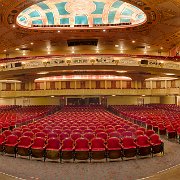
19 The Capitol Theatre was considered Detroit’s first official movie palace, and when it opened January 12, 1922, it sat about 3,500, the fifth largest ever built in the US at the time.
Its architect, C. Howard Crane, designed the Capitol Theatre in the style of the Italian Renaissance, and its facade, with its soaring Corinthian columns, loomed over Broadway like a royal palace. Its interior was even more ornate, with several kinds of marble, Tiffany mosaics, sculpture and gilt decorating its lobby and other areas. The Capitol Theatre is said to have cost over $2 million to build.
The 35-piece ‘Great Capitol Wonder Orchestra’, led by Eduard Werner, was on hand opening day, and remained a popular feature of the theatre until he left the Capitol Theatre for the Michigan Theater in 1926. On screen, “The Lotus Eater” was shown, as well as footage of guests entering the theatre two hours earlier, much to the audience’s amazement and delight.
The theatre’s name was changed to the Paramount Theatre on August 30, 1929, when it was taken over by the Paramount-Publix chain, and featured live stage shows and vaudeville acts. Stars who appeared on the Paramount Theatre’s stage in those days included W.C. Fields, Fatty Arbuckle, and Guy Lombardo and his Orchestra.
As a result of the Depression, the theatre closed in 1932, but only until August31, 1934, when it reopened under United Detroit Theaters with another new name, this time the Broadway-Capitol Theatre.
In the 1940’s and 1950’s, management of the theatre passed back and forth between various parties, but it was managed by United Detroit Theaters once again beginning in 1960.
For most of the 1950’s, the Broadway-Capitol Theatre featured second-run films and double-features, and unlike many other area theatres, did not convert to the widescreen format to attract audiences.
It was in 1960 that United Detroit Theaters poured over $100,000 into remodeling the theatre, completely changing its facade and slightly reducing its seating capacity.
It was also given yet another new name during this time, the Grand Circus Theatre, continuing to screen second-run films. The theatre often struggled during the 1960’s and 1970’s, but remained open until 1978, with the last film on its screen being “Jailbait Babysitter”.
During the early-to-mid-1980’s, the Grand Circus Theatre was used for concerts, but was forced to close in 1985 after a fire broke out.
In 1989, the Michigan Opera Theatre purchased the Grand Circus Theatre and nearby Madison Theatre for $3.5 million and began a $20 million campaign to restore the interior of the old Capitol Theatre to its 1920’s appearance, enlarge its stage, improve the sound and lighting systems, and reduce seating to a more comfortable 2,700.
It now serves as the Detroit Opera House.
Its architect, C. Howard Crane, designed the Capitol Theatre in the style of the Italian Renaissance, and its facade, with its soaring Corinthian columns, loomed over Broadway like a royal palace. Its interior was even more ornate, with several kinds of marble, Tiffany mosaics, sculpture and gilt decorating its lobby and other areas. The Capitol Theatre is said to have cost over $2 million to build.
The 35-piece ‘Great Capitol Wonder Orchestra’, led by Eduard Werner, was on hand opening day, and remained a popular feature of the theatre until he left the Capitol Theatre for the Michigan Theater in 1926. On screen, “The Lotus Eater” was shown, as well as footage of guests entering the theatre two hours earlier, much to the audience’s amazement and delight.
The theatre’s name was changed to the Paramount Theatre on August 30, 1929, when it was taken over by the Paramount-Publix chain, and featured live stage shows and vaudeville acts. Stars who appeared on the Paramount Theatre’s stage in those days included W.C. Fields, Fatty Arbuckle, and Guy Lombardo and his Orchestra.
As a result of the Depression, the theatre closed in 1932, but only until August31, 1934, when it reopened under United Detroit Theaters with another new name, this time the Broadway-Capitol Theatre.
In the 1940’s and 1950’s, management of the theatre passed back and forth between various parties, but it was managed by United Detroit Theaters once again beginning in 1960.
For most of the 1950’s, the Broadway-Capitol Theatre featured second-run films and double-features, and unlike many other area theatres, did not convert to the widescreen format to attract audiences.
It was in 1960 that United Detroit Theaters poured over $100,000 into remodeling the theatre, completely changing its facade and slightly reducing its seating capacity.
It was also given yet another new name during this time, the Grand Circus Theatre, continuing to screen second-run films. The theatre often struggled during the 1960’s and 1970’s, but remained open until 1978, with the last film on its screen being “Jailbait Babysitter”.
During the early-to-mid-1980’s, the Grand Circus Theatre was used for concerts, but was forced to close in 1985 after a fire broke out.
In 1989, the Michigan Opera Theatre purchased the Grand Circus Theatre and nearby Madison Theatre for $3.5 million and began a $20 million campaign to restore the interior of the old Capitol Theatre to its 1920’s appearance, enlarge its stage, improve the sound and lighting systems, and reduce seating to a more comfortable 2,700.
It now serves as the Detroit Opera House.
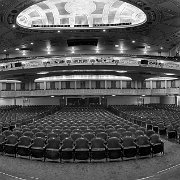
20 The Capitol Theatre was considered Detroit’s first official movie palace, and when it opened January 12, 1922, it sat about 3,500, the fifth largest ever built in the US at the time.
Its architect, C. Howard Crane, designed the Capitol Theatre in the style of the Italian Renaissance, and its facade, with its soaring Corinthian columns, loomed over Broadway like a royal palace. Its interior was even more ornate, with several kinds of marble, Tiffany mosaics, sculpture and gilt decorating its lobby and other areas. The Capitol Theatre is said to have cost over $2 million to build.
The 35-piece ‘Great Capitol Wonder Orchestra’, led by Eduard Werner, was on hand opening day, and remained a popular feature of the theatre until he left the Capitol Theatre for the Michigan Theater in 1926. On screen, “The Lotus Eater” was shown, as well as footage of guests entering the theatre two hours earlier, much to the audience’s amazement and delight.
The theatre’s name was changed to the Paramount Theatre on August 30, 1929, when it was taken over by the Paramount-Publix chain, and featured live stage shows and vaudeville acts. Stars who appeared on the Paramount Theatre’s stage in those days included W.C. Fields, Fatty Arbuckle, and Guy Lombardo and his Orchestra.
As a result of the Depression, the theatre closed in 1932, but only until August31, 1934, when it reopened under United Detroit Theaters with another new name, this time the Broadway-Capitol Theatre.
In the 1940’s and 1950’s, management of the theatre passed back and forth between various parties, but it was managed by United Detroit Theaters once again beginning in 1960.
For most of the 1950’s, the Broadway-Capitol Theatre featured second-run films and double-features, and unlike many other area theatres, did not convert to the widescreen format to attract audiences.
It was in 1960 that United Detroit Theaters poured over $100,000 into remodeling the theatre, completely changing its facade and slightly reducing its seating capacity.
It was also given yet another new name during this time, the Grand Circus Theatre, continuing to screen second-run films. The theatre often struggled during the 1960’s and 1970’s, but remained open until 1978, with the last film on its screen being “Jailbait Babysitter”.
During the early-to-mid-1980’s, the Grand Circus Theatre was used for concerts, but was forced to close in 1985 after a fire broke out.
In 1989, the Michigan Opera Theatre purchased the Grand Circus Theatre and nearby Madison Theatre for $3.5 million and began a $20 million campaign to restore the interior of the old Capitol Theatre to its 1920’s appearance, enlarge its stage, improve the sound and lighting systems, and reduce seating to a more comfortable 2,700.
It now serves as the Detroit Opera House.
Its architect, C. Howard Crane, designed the Capitol Theatre in the style of the Italian Renaissance, and its facade, with its soaring Corinthian columns, loomed over Broadway like a royal palace. Its interior was even more ornate, with several kinds of marble, Tiffany mosaics, sculpture and gilt decorating its lobby and other areas. The Capitol Theatre is said to have cost over $2 million to build.
The 35-piece ‘Great Capitol Wonder Orchestra’, led by Eduard Werner, was on hand opening day, and remained a popular feature of the theatre until he left the Capitol Theatre for the Michigan Theater in 1926. On screen, “The Lotus Eater” was shown, as well as footage of guests entering the theatre two hours earlier, much to the audience’s amazement and delight.
The theatre’s name was changed to the Paramount Theatre on August 30, 1929, when it was taken over by the Paramount-Publix chain, and featured live stage shows and vaudeville acts. Stars who appeared on the Paramount Theatre’s stage in those days included W.C. Fields, Fatty Arbuckle, and Guy Lombardo and his Orchestra.
As a result of the Depression, the theatre closed in 1932, but only until August31, 1934, when it reopened under United Detroit Theaters with another new name, this time the Broadway-Capitol Theatre.
In the 1940’s and 1950’s, management of the theatre passed back and forth between various parties, but it was managed by United Detroit Theaters once again beginning in 1960.
For most of the 1950’s, the Broadway-Capitol Theatre featured second-run films and double-features, and unlike many other area theatres, did not convert to the widescreen format to attract audiences.
It was in 1960 that United Detroit Theaters poured over $100,000 into remodeling the theatre, completely changing its facade and slightly reducing its seating capacity.
It was also given yet another new name during this time, the Grand Circus Theatre, continuing to screen second-run films. The theatre often struggled during the 1960’s and 1970’s, but remained open until 1978, with the last film on its screen being “Jailbait Babysitter”.
During the early-to-mid-1980’s, the Grand Circus Theatre was used for concerts, but was forced to close in 1985 after a fire broke out.
In 1989, the Michigan Opera Theatre purchased the Grand Circus Theatre and nearby Madison Theatre for $3.5 million and began a $20 million campaign to restore the interior of the old Capitol Theatre to its 1920’s appearance, enlarge its stage, improve the sound and lighting systems, and reduce seating to a more comfortable 2,700.
It now serves as the Detroit Opera House.
Detroit Opera House